
Want to get a grip? Then grab a pair of the most popular kind of minimalist shoes, flip-flops, and put them on your feet. Now walk, and feel the flexors of your ankles and toes grip, literally. Meet your flexor digitorum longus. Entombed deep to the gastrocnemius and soleus in the lower leg, the flexor digitorum longus flexes the second through fifth toes, inverts the foot, and aids in plantar flexion of the ankle.
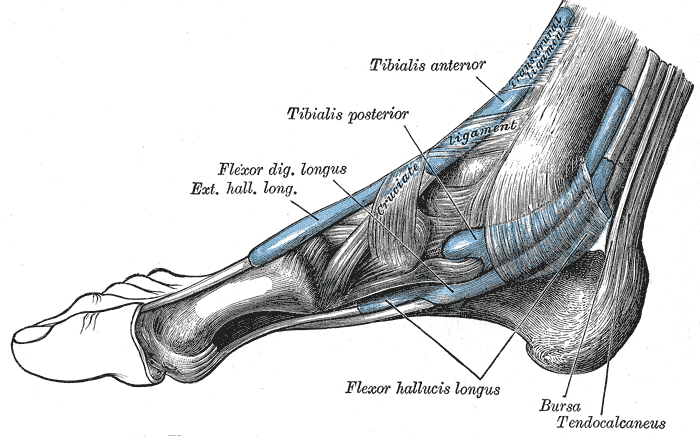
Originating in the middle of the posterior surface of the tibia and traveling down the leg inserting in the distal phalanges of the second through fifth toes, the flexor digitorum longus (FDL) is one of three ankle and toes flexors. Along with the tibialis posterior and the flexor halluces longus (FHL), the other foot flexors, this narrow muscle is a primary player in tiptoeing, navigating rocky trails and picking up small objects off the floor with the toes.
When wearing loose fitting flip type shoes that do not connect to your foot, the FDL has to work extra hard, along with the FHL, to hold the shoe in place so you don’t flop, I mean fall. The gripping of the FDL can result in a change in normal dorsiflexion during the swing phase of the gait cycle. The over-emphasized flexing action on the bottom of the foot can have detrimental effects on the gait cycle of the sandal wearer. It can lead to pain in the heel, in the metatarsophalangeal and interphalangeal joints, in the plantar fascia, and may also cause discomfort up the anterior and lateral side of the lower leg, reaching all the way up through the IT band. Mainly, as we are focusing on the flexor digitorum longus, this slim muscle has to do a heck of a lot of overtime when the action of toe flexion is called upon so intensely.
Though the warmer months are rapidly approaching, switch out the flip-flops for footwear that connects to your feet and save your flexor digitorum longus for hiking in the woods, walking barefoot in the rain, and for some of your favorite standing balanced yoga poses like Half Moon and Tree Pose. Get a real grip and ditch the flips!
Read more on the negative side effects of flip flops
Watch the QuickFix Feet & Ankle Video
Check out our recommended foot & ankle pain solutions



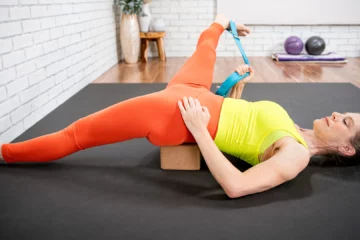

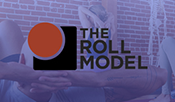



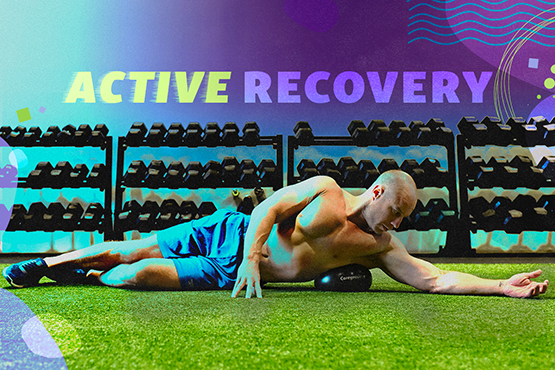
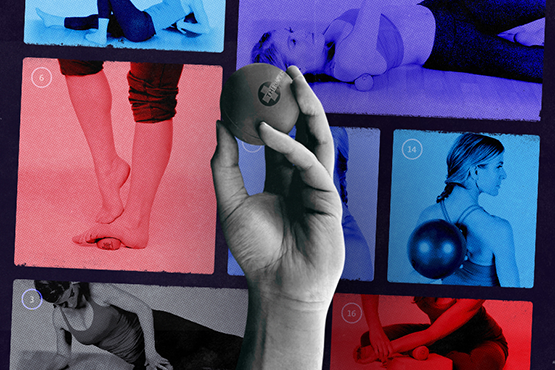
I appreciate the anatomy lesson in why our feet feel so sore after long periods of wearing flip flops. Normally I limit use of flips to wearing to the yoga studio or the pool, but after this lesson I’m questioning this decision. Thank you for the reminder to take care of our feet!
Do Fit flops also cause problems? They feel so supportive and are one of the few shoes I can wear for any length of time without pain.
You just made my spring cleaning easier. The cheap flip flops are going to charity or garbage. Since becoming a yoga teacher and spending more time in barefeet, I wear something more supportive like birkenstocks. My toes are still grabbing but overall my feet are happier.
This is a hard pill for me to swallow. I would wear flip-flops every day in an endless summer if I could because I love the freedom they allow for (I hate wearing shoes) I appreciate the reminder of the effect on my body though, and I should be able to manage without them. Thanks Laurie!
As a yogi I too prefer footwear thats easy to put on and take off, never realized the impact the lack of support had on my feet especially the tightness in the bottoms and tops of them. I thought it related to something else but now I see that my choice of footwear has been the culprit.
I have never understood people’s love affair with flipflops – who wants to work that hard to hold shoes on their feet? Not me! So I was pleased to find out that by avoiding flipflops I have also avoided many foot and leg aches and pains that many others experience. Thanks for the description on which muscles are being affected – I always mainly think about the bottom of the foot when I think of negative affects of wearing flipflops, and not the front of the leg, but this makes it make complete sense.
I’ve been reading a lot about the FDL and FHL, and it’s wonderful to read about them in a real application. We’ve all worn those shoes that are bad for our feet–but to hear about the consequences of flip flops in terms of the muscles that are affected, and what it leads to ultimately is really helpful. It also helps me as I study these muscles–I’m even wearing flops right now and see exactly what you mean!
I very rarely wear flip flops anymore, but when I do they aren’t those cheap $1 ones that you can buy. I see so many people wearing them, and I have so many people coming into my office complaining of foot pain. Our feet take so much abuse, carrying us around all day, we really need to start treating them better!
I love flip flops, but must admit sometimes the top my foot does ache if I walk too long in them. Toes should be free to spread out and not have to grip to hold onto floppy footwear.! One style of sandal that I have never been able to wear is the now once again fashionable mule style. They hurt as soon as I take a few steps. I have bought them in past fashionable years and never been able to get use from them because of the instant discomfort I feel and how they change my walk, so I made a decision never to buy any again. Shoe fashion for women in general does not promote healthy functioning of the foot, oh what we subject ourselves to! Let’s get more people to understand how healthy their feet can be with regular rolling and sensible footwear!
This is very helpful to explain the negative side-effects of flip-flop wearing. Since practicing Yoga Tune Up and reading Katy Bowman I have been more aware of what my feet and toes are up (or down) to. I started noticing discomfort in what I now know is my FDL and the anterior of my lower leg . I quit wearing flip-flops and my Birkenstock clogs. I am now building my collection of barefoot shoes and sandals.
I have sort of been aware of this and have been reducing the use of flip flops but after reading this I AM DITCHING THEM! THANKS.
Nice, thank you for the blog! I wonder if this relates to hammer toes as well? With one client who rolls their anterior tibialis they will experience some softening in the hammer toes.
Brilliant ! Now I get to go shoe shopping ! This is the BEST reason to buy a new pair of shoes so far 🙂
I have just recently binned my flip flops! thank you for this article! This will give me great references for my clients! Science and facts, gotta love it!
Thank you for the reminder to choose proper footwear- supporting our feet only help the responsibility they have- moving us around all over the place and support our weight while we do so! Just being barefoot is not something people do a lot of anymore, we are constantly abusing our feet. I love all of the foot work in the day 4 restorative hip sequence in level 1- so important and beneficial.
In addition to clenching, I noticed that I drag my heels. That stiffness throughout the foot probably translates all the way up the leg and into the hip.
This issue keeps me quite busy in the clinic room during the warmer months, great info for the public and something I discuss with my clients regularly. Another great example of ways to teach people self care maintenance between treatments.
Thank you for the clear explanation concerning this issue. I know understand why my feet also feel wonky even after wearing flip flops for a short time, like walking and forth at the gym either in the pool area or locker room.
Great education on the hazzards of flip-flops! I gave them up for a six month period of time to “see” what would happen. When I put them on again, they were literally flying off my feet! I’d let go of all that clenching action.
Excellent article Laurie. I do wear flip flops 365 days a year, due to a climate and lifestyle I live. To keep my foot articulation in a good shape, I try to walk barefoot wherever possible and suitable. Now I add YTU ball rolling and therapeutic foot template poses like Sitting Seza, Interlaced Toes, Namaste Feet, etc.
I just cannot give up flip flops! Way too convenient for the beach.
Very valuable observation; thank you for sharing.
This is exactly why I’ve given up flip-flops! I have Vivobarefoot minimal sandals that have a back-strap to keep this from happening. I always remember wondering why my feet would be so sore after walking around in flip-flops all day. I used to assume it was because I needed to condition my feet to wearing them. Thankfully, I know better now! It’s definitely painful watching other people walk in flip-flops though — all that toe gripping and arch collapsing is so ugly!
Great explanation of the flop of the flip-flop. My first experience of flip flops saw me shuffling along wondering how people managed to keep them on their feet successfully. Fast forward a couple of years and having just become adept at the flip-flop run, I too picked up Katy Bowman’s book and was confronted with the possibility that my new skill was actually biomechanically bad for me. Now I am wondering if my flip flop use explains my poor toe articulation. Thanks for being such a resource of helpful information.
I often wear flip flops. and after reading Kate Bowman’s book “move your DNA”, I thought I was on the right track about minimalist footwear! this in-depth explanation has really opened my eyes to the excessive contracting the flexor muscles under the foot. Question: would this also help explain why my foot so easily goes into a cramp?
You can really notice how the FDL is overworking when you run in flip flops because your whole foot has to really grip the sandal in order to not go flying in the air!
I wear them sparingly now; mostly to the pool or the beach. Had I read this post sooner, I probably wouldn’t have backpacked in flip flops for three weeks in Europe a few years ago…
I’ve never enjoyed wearing flip flops because they ‘tired my feet out’ from clenching my toes. Now I understand more specifically what was happening that made my feet unhappy.
I have to admit I love wearing flip flops. It was recently brought to my attention that wearing flip flops were not a good idea because it weakens the arches and because my feet are flat I now know that I have not been giving my feet the proper love. Would berkinstocks be a good alternative because of the support that it gives to the arches?
Yup, so true. We need our arches and if we constantly wear non arch supporting footwear, we shall need to knead our feet and calves with YTU balls!!! thankfully there is a reverse mode!
I ditched my high heels a while ago and my next step is leaving my flip flops behind. In winter I am an ugg slipper repeat offender. I love how easy the shoes are to throw on. The accessibility of the shoes should not over ride what is going on anatomically inside of me when I put them on. Now I have an excuse to go sneaker shopping!
Thanks for this great advice. When croc like shoes came out I was told that they were a great way to exercise the foot but I started wearing them all the time because they were so easy to get in and out of at yoga studios. Unfortunately I developed plantar fasciitis and often wondered if I could have avoided that by wearing other shoes or spending more time being barefoot. What about the five finger toe shoes? Any opinions on them?
I have never been a fan of flip flops. The lack of protection and support makes them a prime suspect when looking at foot, ankle, and knee problems. It also is a good point to note that when a person complains of lower limb problems a good question to ask is about that person’s footwear, because even shoes with proper arch and ankle support that have worn soles can also lead to problems.
How do flip-flops compare with Vibrams or going barefoot? I’ve had teachers recommend wearing shoes as little as possible (obviously you have to while out and about but they advocated it at home and in barefoot-friendly environments). Is this good advice?
Great article with thorough explanation! I do think it’s a bit unrealistic to completely forego flip flops in every day life, especially in southern California. Sure we can make sure we are wearing proper footwear when we go on longer walks, etc., but I still plan on wearing them when heading to the beach! I agree with Elizabeth that some YTU techniques for this muscle would be appreciated.
Thank you. My feet have been hurting in these types of shoes. Looks Like its time for a wardrobe change!!
I loved this blog post! So entertaining and educational 🙂 I’ve been reading a lot of Katy Bowman stuff because my feet have developed hammer toes, collapsed arches and who knows what else! This was a helpful read on the mechanics of the foot and how one decision can affect the rest of the body. I find that my calves are tight, IT band area and lateral hip/butt area. I’ve been walking barefoot and rolling my feet out every day, so far its been a month and I can already tell the mechanics of feet, knees and hips are starting to change.
I gave up wearing flip flops when I had a debilitating case of plantar fasciitis several years ago. The podiatrist I saw said that the flip flops I had been wearing all spring and summer were probably the culprit. I have spent time reading up on the damaging results of wearing shoes without heel support. I wish more people would heed this advice. Unfortunately most people wave it away until the day they are in too much pain to ignore it.
As a yoga teacher, I wear flip flops almost every day for the ease of stepping in and out of the studio. I’ve started to notice on my dog walks that my knees have been sore when I wear the flip flops over my sneakers. I have a feeling that my overused flexor digitorum longus is translating up into my tibalis anterior & posterior. Thanks for this article… I’ve noticed that the YTU teachers all wear sneakers or supported shoes rather than the flops.
Towards the end of last year I started to develop a sharp pain in my heel and arch of my right foor on waking. The pain typically subsided as the day went on, provided I didn’t stand for too long. After last summer I had started doing some short hikes in the local nature preserve and was wearing some lightweight, ankle high, hiking boots. I’ve ditched the boot, am wearing much more flexible athletic shoes and working with the tune up balls. All of that has equalled much happier feet.
Wow, I actually understood this. Thanks Trina!
Laurie- Are sandals okay as long as they have an ankle strap? Is there a specific type/brand you recommend?
I am a flip flopper. reading this make me suspect my keen issue has a lot to do with this.too. also one of my body is longer than other side. without fitting the right proper shoe support, plus running few miles a day will do a big damage in the future. People who run and walk on bare foot should really read this.
You read so much about closed shoes being foot coffins and constricting the feet that you would think something as open as a flip flop would be better – guess not! I wear flip flops almost exclusively, year round, though luckily I do spent most of the day barefoot. But I’ll have to rethink that, especially if it could affect me doing my favorite pose Half Moon!
Love this blog. I have told my students many times that wearing flip-flops are not the best things for your feet. (Must confess to wearing them) but usually in showers or on the way from a dressing room into the pool. However, even that is probably not good for the foot. Keep reminding me and others to ditch the flip-flops.
I love flip flops and wear them all the time during the summer months. I am beginning to notice discomfort up the anterior and lateral side of the lower leg. I am also feeling tightness up to my IT band. I thought it was from running. I do have some clients complaining about pain in the heel. I will ask them how much they wear flip flops and send them this article. Thanks!
I love walking barefoot as much as possible, and flip flops are so easy to throw on. My sister was a PT and said walking barefoot was terrible for my arches. after years of doing this, I’ve been having a lot of foot/arch pain when I get out of bed and stand up first thing in the morning. I suspect plantar’s fascitis, and after reading this blog, I’m guessing the flip flops and barefoot are the culprits. I will definitely start using the YTU balls on my feet. Are there any good sandals you can recommend that I could easily slip on/wear around the house that provide good arch support (e.g. Berkenstocks)?
Great article! Wore flip flops non-stop for some time living in the tropics. I have to say I prefer flexor dig. longus overuse to underuse such as I’ve experienced wearing heavy winter boots with hard soles. Thank you for highlighting the importance of footwear. I’m trying out the vibram 5 finger toes shoes for trail running this summer and I’m hoping my functional foot prayers will be answered
Is the effect the same with a sandal which can be ‘fastened’ to your foot, such as a Birkenstock?
Walking bare foot is a great way to strengthen the feet and help maintain your natural arches. Although I agree flip flops are terrible for your feet, minimalist shoes for the most part come with shoe laces and can be secured enough to be healthier for your feet than typical shoes with high arches. Train yourself (gradually) to wear flat soled shoes.
Wow! It’s amazing how one small piece of footwear can cause so many issues all the way up the leg. I knew that flip flops weren’t the best choice but didn’t fully understand the implications of over use of the FDL. Definitely something to consider when purchasing summer footwear. Now – where to find cute sandals that are more connected to your feet.
Over the past few years I’ve followed the sun and worked on cruise ships. Anytime I would get off the ship you had to go through security, so I wore the pair of shoes I knew would be easy to take on and off…Flip flops. Over time I would wake up feeling as if I had plantar fasciitis and over all tightness in the bottoms of my feet. After putting 2 and 2 together, this makes some sense. But unfortunately they wouldn’t have let me off without shoes. Great information here, I’m only just started my certification, so there’s still some words I don’t understand yet, but soon enough! Thanks 🙂
I have to confess that I love wearing my flip flops. They are a signal that the long winter is over and the heady days of summer have finally arrived. Especially after this past winter where we were stuck in a deep freeze for so long. However, I know that they are not good for my feet and after a day in them I notice not only are my feet tired but my back will be more fatigued as well. So, I’ll stick to more stable footwear for the most part, roll out my feet and celebrate by walking barefoot where possible!
When you refer to flip-flops, I suspect that you are also encompassing most forms of sandals, not just the cheap thong sandals but also the ever-popular cork based slip on sandals. I know I can’t dispute the arguments made in you blog, but I also can’t help but feel defensive about my choice footwear. I’m sure all sandals are terrible for your feet, though I am also sure that some are superior to the traditional thong flip-flop. Until I’m ready to ditch them, perhaps you could suggest a few TuneUp techniques to minimize the negative effects?
True that flip flops certainly create an issue with overuse of the FDL.
I am barefoot most of the time and wear flip flops minimally. I have stabbing almost electrocution style pain that shoots into my 3 metatarsal of my right foot. the intensity of the pain peaks on the push off phase of walking only. Any insight on this ? is it a tight FDL or other?
Thanks
I wanted to leave a comment of thanks to you Laurie. I have been teaching yoga for a few years now and have given the remedy of ‘lifting the toes’ to so many of my students for their plantar fasciitis complaints but had never read the explanation about the where and what’s of why this can happen. Recently, I have fallen victim, or atleast my feet have, to not taking care of my own foot awareness and have been suffering with quite painful big toe joints. I’ll look that up someday and know it’s real name or maybe you could do that for me! As a teacher, I will always be my own student and to that end, thank you for reminding me to counter the scrunch in my toes which you have also reminded me that it will connect call the way up to my head if I’m not careful. Thanks again from Ottawa and yoga tune up training!
Thanks for a great article. I’ll be sending this to many flip flopping wearing friends and clients. Next time anyone complains about how much their feet hurt, I will send this article and remind them to roll out the balls on their poor feet.